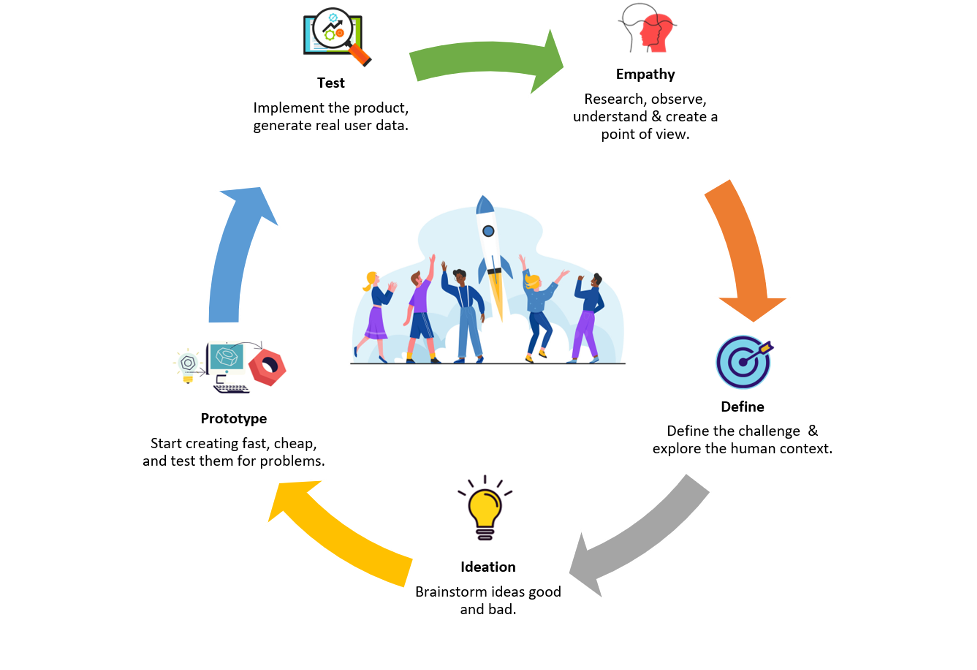Innovate With Design Thinking
Are You A Startup Wanting To Innovate? Answer These 5 Questions For Yourself.
Startups are in the business of ideas
Ideas are the foundation of Startups. Any startup that has seen a significant amount of success has been able to do that by tapping into an unmet market need or innovating around the product, marketing or distribution, and other ideas. Founders of Airbnb, Uber, Dropbox, Netflix built their businesses around a critical consumer insight or pain-point. Even the success of companies like Apple and Amazon, while not the first players in touch-screen phones or e-commerce, was built upon how they reimagined the user experience. These were stylus-free devices, ease-of-use and the disruptive AppStore in the case of Apple; same-day-delivery, Amazon-verified and Prime, in the case of Amazon.
The Epiphany
Dropbox founder Drew Houston famously conceived the Dropbox concept after repeatedly forgetting his USB flash drive while he was a student at MIT. He built storage for himself in the cloud before realising that others had similar challenges and could use it too! Similarly, Brian Chesky and Joe Gebbia were broke and looking to raise money to make their rent in San Francisco. Since all hotels in the city were sold out, they decided to rent out air mattresses in their apartment to attendees of a conference. They called their service “Air Bed and Breakfast.” In a few years, this small experiment would create the hotel industry disruptor Airbnb. Closer home, Ritesh Agarwal found the lack of basic, hygienic and standardised services in the budget hotel segment in his travels across the country and launched Oyo.
So, how does one bring about these insights? The examples shared above talk about innovations and breakthroughs achieved after a personal experience with a specific pain point and how they addressed it. Does that mean that innovations can only happen once we go through a life-changing experience and then an epiphany hits us? Thankfully, no.
Design Thinking
Of course, customer empathy, or understanding the challenge or a pain-point that a customer faces, is key to coming up with innovations. However, what Design Thinking tells us is that we can follow a process, rather than wait for that personal experience and hopefully the ensuing epiphany, to gain that invaluable insight and the breakthrough innovation.
IDEO, the design and consulting firm, is often credited with inventing the term “design thinking” and its practice. They have been practising human-centred design since their establishment in 1978 and took up the phrase “design thinking” to describe the elements of the method they found most learnable and teachable - empathy, optimism, iteration, creative confidence, experimentation, and an embrace of ambiguity and failure. Similarly, according to Stanford d.school, Design Thinking involves five stages – Empathise, Define, Ideate, Prototype, and Test.
The 5 Important Questions
Working with a lot of startups, Equanimity applies Design Thinking principles to explore new product ideas, brainstorm product-market fit, and think about new ways to go to market. To ensure that we speak the same language, we have based our model on the Design Thinking framework taught at the Darden School of Business, which involves asking 4 (in our case, 5) simple, yet critical questions. What is, what if, what wows, what works and what sells?
What is?
This question explores current reality. All successful innovation begins with an accurate assessment of what is going on today. Indeed, starting by developing a better understanding of everyday reality is a hallmark of design thinking, and it is the core of design’s data-intensive and user-driven approach. It further helps us broaden or perhaps even completely change our perception of the problem we want to address. Secondly, it helps us uncover all sorts of unarticulated needs, or latent or unmet needs, which can be the key to producing breakthrough innovation.
What if?
This question is the part where we brainstorm to start generating ideas and explore possibilities. By aligning with the opportunities and not the constraints, we ensure that we focus on charting out a different future from where we are now. This step is perhaps the most critical part of the entire process
What wows?
This question is where we start examining our ideas and giving them a close, hard look and evaluating them against our design criteria. It is a complicated process as we have to whittle down the options to a few. A great wow idea would be one that would provide a significant upside for our stakeholders, i.e. customers, and match the organisation’s resources and capabilities to deliver the solution.
What works?
The concepts that wow are good candidates for turning into experiments to be conducted with actual users. We need to transform these concepts into something a potential customer can interact with - a prototype. Once we get feedback from real customers, the idea is to refine this prototype and get some more feedback quickly. This series of iterative experiments will promptly tell us which idea has value and potential and if we can scale it
What sells?
This inquiry may not be possible in all cases. However, in some scenarios, like B2B or SaaS businesses, it might be possible to showcase the product innovation or features arising out of step 4 and test the case for market viability by getting some early-paying customers or customers even willing to pay for a feature in advance. This step helps discerning whether the innovation has a genuine market in the real world or whether it suffers from confirmation bias.
So, that’s it. These five questions can help you find the way to more innovative solutions for your product or service. The more you practice with this, the more efficient and effective you can become in applying design thinking principles to achieve that breakthrough. Go ahead, give it a shot. Your eureka moment awaits you!



